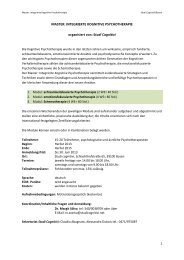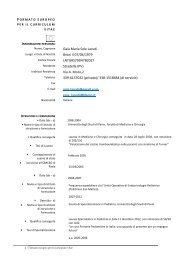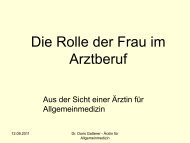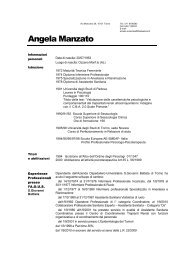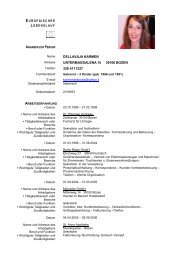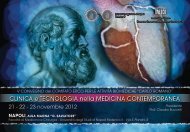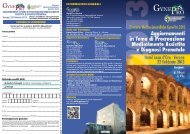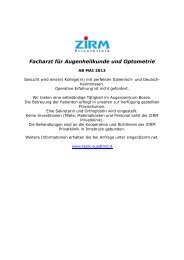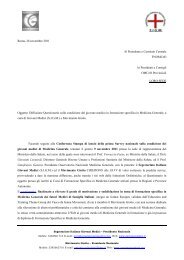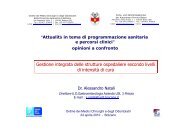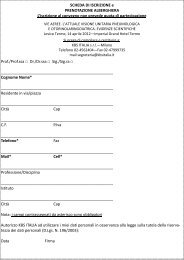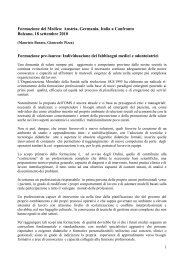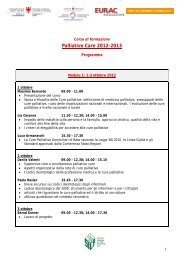Numero 11 - Istituto Superiore di SanitÃ
Numero 11 - Istituto Superiore di SanitÃ
Numero 11 - Istituto Superiore di SanitÃ
Create successful ePaper yourself
Turn your PDF publications into a flip-book with our unique Google optimized e-Paper software.
E<strong>di</strong>toriale<br />
Il fil rouge <strong>di</strong> questo numero del Supplemento “Malattie<br />
rare e farmaci orfani” del Notiziario dell'<strong>Istituto</strong> <strong>Superiore</strong><br />
<strong>di</strong> Sanità è la comunicazione.<br />
L’articolo incentrato sulla comunicazione efficace<br />
illustra come, nell’ambito delle malattie rare (MR) già<br />
per loro natura complesse, siano necessari interventi<br />
caratterizzati dall’attivazione <strong>di</strong> processi comunicativi<br />
integrati tra Istituzioni, Associazioni <strong>di</strong> pazienti e<br />
familiari. In questo senso è molto interessante anche il<br />
modello offerto dal Centro Malattie Rare della Provincia<br />
Autonoma <strong>di</strong> Trento.<br />
Tali processi, da un lato, dovrebbero fornire la circolarità<br />
dell’informazione e la collaborazione integrata<br />
all’interno della rete; dall’altro, offrire la possibilità <strong>di</strong><br />
realizzare interventi centrati sulle esigenze della persona<br />
con MR e della sua famiglia. In questa <strong>di</strong>rezione sono<br />
orientati molti progetti e attività del Centro Nazionale<br />
Malattie Rare dell’<strong>Istituto</strong> <strong>Superiore</strong> <strong>di</strong> Sanità (ISS): dal<br />
Telefono Verde Malattie Rare a corsi <strong>di</strong> formazione specifici,<br />
al Laboratorio <strong>di</strong> me<strong>di</strong>cina narrativa.<br />
Verterà sui medesimi temi, e soprattutto sul rapporto<br />
me<strong>di</strong>co-paziente, anche la lettura magistrale che<br />
Gianni Bonadonna terrà durante il 3° Convegno nazionale<br />
“Me<strong>di</strong>cina narrativa e malattie rare”, organizzato presso<br />
l'ISS il 13 giugno 20<strong>11</strong>.<br />
Gli aspetti comunicativo-relazionali emergono<br />
con maggior vigore, infine, dalle storie <strong>di</strong> me<strong>di</strong>cina<br />
narrativa pubblicate in questo numero, e incentrate<br />
sull’esperienza <strong>di</strong>rette <strong>di</strong> due coppie <strong>di</strong> genitori. Come<br />
sempre, è de<strong>di</strong>cato ampio spazio alle Associazioni e<br />
agli appuntamenti nazionali e internazionali riguardanti<br />
le MR come, ad esempio, la Conferenza finale del<br />
Progetto EUROPLAN del 25 febbraio 20<strong>11</strong>. Anche in<br />
quest’evento, d’altra parte, la comunicazione tra tutti<br />
gli stakeholder, a livello nazionale e internazionale,<br />
ha avuto un ruolo fondamentale e imprescin<strong>di</strong>bile, al<br />
fine <strong>di</strong> elaborare raccomandazioni per sviluppare piani<br />
nazionali sulle MR.<br />
Domenica Taruscio<br />
Direttore del Centro Nazionale Malattie Rare<br />
This issue of the Supplement of Notiziario dell'<strong>Istituto</strong><br />
<strong>Superiore</strong> <strong>di</strong> Sanità is mainly focused on communication.<br />
In particular, a specific article is de<strong>di</strong>cated to effective<br />
communication and rare <strong>di</strong>seases pointing out that inclusive<br />
communication and cooperation among institutions,<br />
patient’s associations and families are needed to enable<br />
consistent and harmonizing policies for the management<br />
of rare <strong>di</strong>seases. In this context, it seems very interesting<br />
the model proposed by the Center for Rare Diseases of the<br />
Provincia Autonoma <strong>di</strong> Trento, based on a hug collaboration<br />
between Region and <strong>di</strong>strict.<br />
The activation of these specific processes based on<br />
effective communication should empower, support, and<br />
facilitate information and collaboration within the rare<br />
<strong>di</strong>seases network; furthermore, it should offer the possibility<br />
to realize specific actions based on the real necessity<br />
of patients and their families. The activity of the National<br />
Center for Rare Diseases of the Italian National Institute of<br />
Health is addressed to this process through the implementation<br />
of specific activities such as the help-line, training<br />
courses, Laboratory of narrative me<strong>di</strong>cine, etc.<br />
The lecture of Gianni Bonadonna, which will be<br />
held within the 3rd National Conference on "Narrative<br />
Me<strong>di</strong>cine and rare <strong>di</strong>seases", organized at the Italian<br />
National Institute of Health (June 13th, 20<strong>11</strong>), will be<br />
focused on the above mentioned themes, and in particular<br />
on the specific relationship between physician and<br />
patient.<br />
In this issue we also collect two patient’s families<br />
histories and present the agenda of the events focused<br />
on rare <strong>di</strong>seases, held at national and international<br />
level. Among these, we report on the activity of the<br />
EUROPLAN Conference (February 25th, 20<strong>11</strong>) as an<br />
example of <strong>di</strong>scussion and shared consensus among <strong>di</strong>fferent<br />
stakeholders on the elaboration of recommendations<br />
for the development of specific national plans for<br />
rare <strong>di</strong>seases.<br />
Domenica Taruscio<br />
Director of the National Centre for Rare Diseases<br />
Not Ist Super Sanità 20<strong>11</strong>;24(4 Suppl. 1):3 3



